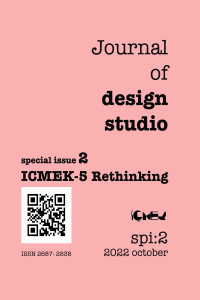On the Interaction Between Shared Design Studios and Interior Architecture Students: A New Spatial Experience with Extended Reality for Supporting Place Attachment
On the Interaction Between Shared Design Studios and Interior Architecture Students: A New Spatial Experience with Extended Reality for Supporting Place Attachment
Place attachment is one of the basic psychological needs in the human-space relationship. Itis known that the characteristics of the shared design studios have a direct effect on the space adaptationof the user. Place attachment occurs simultaneously with the space adaptation process of the students,therefore these two concepts have a direct relationship with each other. Open and flexible activities inshared design studios reduces the adaptation and working efficiency of the students. It can be said thatthis situation will cause problems in the sense of belonging to that kind of learning environments. It isknown that the user of the shared workspace tends to personalize the studios as a result of the need forbelonging in the place adaptation status. The process of the study is trifold; first the concept of shareddesign studios was examined and researches on the concepts of personalization and belonging wereconveyed through literature reviews in order to reveal the interior design students and shared designstudio relationship. Then using literature data, a spatial belonging scale was presented to interior designstudents to determine their place attachment status and augmented reality was used to test the tendencyto customize shared studio spaces accordingly. Lastly their affiliation in the hybrid environment andtheir tendency to personalize the space were analyzed.
Keywords:
Shared Design Studios, Place Attachment, Extended reality Personalization, Interior architecture education,
___
- Akyol, D., Çiğdem, A., & Düzenli, T. (2017). Toplumsal Değişim Sürecinde “Kamusal Mekân”ın Dönüşümü. The Journal of Academic Social Science, 5 (56), 545-554.
- Ashraf, S. (1995), New Trends in Architectural Education: Designing the Design Studio, Endorsements by Henry Sanoff and Jon T. Lang.
- Aydınlı, S. (2014). “Paralaks oda: ‘Öğrenmeyi öğrenme’ ortamı olarak stüdyo”, Semra Aydınlı ve Burçin Kürtüncü (der.), Paralaks Oda, İstanbul: Yapı Endüstri Merkezi, s.10-31.
- Baumeister, R. F., & Leary, M. R. (1995). The Need of Belong: Desire for Interpersonal Attachments as a Fundamental Human Motivation. Psychological Bulletin, 17(3), 497-529.
- Busato, V.V., Prins, F.J., Elshout, J.J. & Hamaker, C. (2000). Intellectual ability, learning style, personality, achievement motivation and academic success of psychology students in higher education, Personality and Individual Differences, 29 (6), 1057-1068
- Cimen, T. (2008). Teknolojik Gelişmelerin Sonucunda Değişen Üretim İlişkilerinin, Ofis Yapılarına Etkisi ve Ofis Mekanları. Master Dissertation, İstanbul: İstanbul Technical University.
- Celik Agcadag, İ. (2021). Esnek Çalışma Mekânları: Paylaşımlı Ofisler. The Journal of Academic Social Science, 2021 (112), 90-106.
- Demirbas, O., Demirkan, H., (2000). Privacy Dimensions: A Case Study in the Interior Architecture Design Studio, Journal of Environmental Psychology, 20 (1), 53-64.
- Douglas, D., Gifford, R., (2001), Evaluation of the physical classroom by students and professors: a lens model approach, Educational Research, 43 (3), 295-309.
- Forecast Distribution of the Augmented and Mixed Reality Market Worldwide in 2022. (2016). Statista: https://www.statista.com/statistics/610066/worldwide-forecast-augmented-and-mixed-reality-software-assumptions/
- Freitas, R., & Campos, P. (2008). SMART: A System of Augmented Reality for Teaching 2nd Grade Students. Proceedings of the 22nd British HCI Group Annual Conference on HCI 2008: People and Computers XXII: Culture, Creativity, Interaction (2), 1-5.
- Gustafson, P. (2001). Roots and Routes Exploring the Relationship between Place Attachment and Mobility. Environment and Behavior 33 (5), 667-686.
- Göçer, Ö., Karahan, E., & Oygür İlhan, I. (2017). Esnek Çalışma Mekânlarının Çalışan Memnuniyetine Etkisinin Akıllı Bir Ofis Binası Örneğinde İncelenmesi. Megaron, 13(1), 39-50.
- Lepley, M. (2000). Office Clutter or Meaningful Personal Disp- Lays: The Role of Office Personalization in Employee and Organizational Wellbeing. Journal of Environmental Psychology, 20 (3), 239-255.
- Liamas, R. T. (2021). Worldwide Augmented and Virtual Reality Hardware Forecast Update, 2021–2025: IDC: https://www.idc.com/getdoc.jsp?containerId=US48277021
- Lueth, P. L. O. (2008). The architectural design studio as a learning environment: a qualitative exploration of architecture design student learning experiences in design studios from first-through fourth-year. PhD Dissertation, Iowa State University.
- Samson, P. L. (2015). Fostering Student Engagement: Creative Problem-Solving in Small Group Facilitations. Collected Essays on Learning and Teaching, (8) p.153-164
- Scupelli, P., & Hanington, B. (2016) Design Studio Desk and Shared Place Attachments: A Study on Ownership, Personalization, and Agency. 2016 Conference of the Design Research Society (DRS2016), 27-30 June, Brighton, United Kingdom.
- Shelton, B. E., & Hedley, N. R. (2002). Using Augmented Reality for Teaching Earth-Sun Relationships to Undergraduate Geography Students. The 1st IEEE International Augmented Reality Toolkit Workshop, Darmstadt, 29 September 2002, p.8 http://dx.doi.org/10.1109/ART.2002.1106948
- Yılmaz, Z. (2007). Hannah Arendt’te Özel Alan-Kamusal Alan Ayrımı ve Modern Çağda Toplumsal Alan. PhD Dissertation, Erzurum: Atatürk University.
- Wells, M. M. (2000). Office Clutter or Meaningful Personal Displays: The Role of Office Personalization in Employee and Organizational Well-Being. Journal of Environmental Psychology, 3(20), 239-255.
- URL-1: (2021), Drawing Metter. (2021, April 29). The Beaux-Arts Tradition. Retrieved from https://drawingmatter.org/the-beaux-arts-tradition/
- URL-2: (2021), Bauhaus Imaginista. (Ed.3). On Behalf of Progressive Design Two Modern Campuses in Transcultural Dialogue. Retrieved from https://www.bauhaus imaginista.org/articles/2950/on-behalf-of-progressive-design
- URL-3: (2021), Research Gate. The Hybrid Studio-Introducing Google+ as a Blended Learning Platform for Architectural Design Studio Teaching. Retrieved from https://www.researchgate.net/figure/The-traditional-architecture-and-design-studio-Middle-East-Technical-University Faculty_fig1_325973241
- URL-4: (2021), Unity. (2021). Inspiring examples of extended reality. Retrieved from https://unity.com/pages/industrial-stories
- URL-5: (2021), Wired. (2020, May 13). You Can Now Attend VR Meetings—No Headset Required. Retrieved from https://www.wired.com/story/spatial-vr-ar-collaborative-spaces/
- Yayın Aralığı: Yılda 2 Sayı
- Başlangıç: 2019
- Yayıncı: Orhan HACIHASANOĞLU
